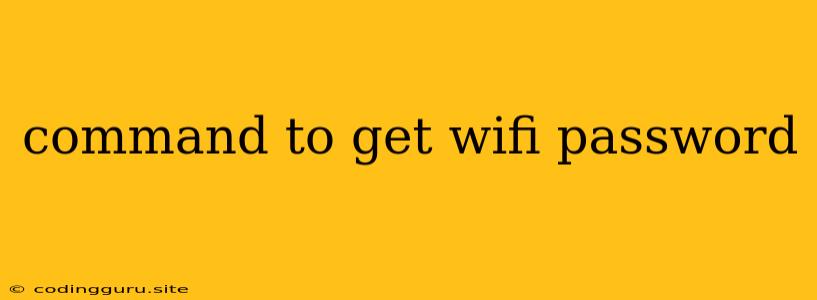How to Find Your Wi-Fi Password: A Comprehensive Guide
It's a common scenario: You need to connect a new device to your Wi-Fi network, but you can't remember the password. Maybe you're setting up a new laptop, a smart TV, or a guest's phone, and you're suddenly facing a frustrating hurdle. Don't worry! There are a few simple ways to recover your Wi-Fi password, depending on your operating system and network setup. Let's explore some of the most effective solutions.
1. Check Your Router's Web Interface
This is the most straightforward approach and often works if you have access to your router.
- Find your router's IP address: Open your web browser and type "192.168.1.1" or "192.168.0.1" into the address bar. These are the most common IP addresses for routers. If these don't work, try searching for your router's model online to find the default IP address.
- Login to your router: You will be prompted to enter your router's username and password. If you haven't changed these, you can often find them on a sticker on the bottom of the router.
- Locate the Wi-Fi password: Once you're logged in, look for a section like "Wireless," "Wi-Fi," or "Security Settings." Within these settings, you'll find your Wi-Fi password listed.
2. Use Windows' Built-in Network Management
For Windows users, finding your Wi-Fi password is surprisingly simple. Here's how:
- Open Network Settings: Right-click on the Wi-Fi icon in your taskbar and select "Open Network & Internet settings."
- Find your network: Navigate to "Wi-Fi" and select the Wi-Fi network you want to access.
- View Properties: Click on the "Properties" button under the network name.
- View the password: Under "Security type," select "Show characters" to reveal your Wi-Fi password.
3. Check Your Mac's Keychain Access
Mac users have a convenient tool for managing passwords called Keychain Access.
- Open Keychain Access: Use Spotlight search to find "Keychain Access."
- Find the network: In Keychain Access, click on "System" in the left sidebar, then search for the name of your Wi-Fi network.
- Reveal the password: Double-click on the network entry, then select "Show Password" in the "Access Control" tab. You'll be prompted to enter your Mac's password for security reasons.
4. Utilize Third-Party Password Managers
If you use a password manager like LastPass, 1Password, or Dashlane, it might have stored your Wi-Fi password for you.
- Open your password manager: Login to your password manager app or website.
- Search for your network: Look for a "Wi-Fi" or "Network" section in your password manager.
- Retrieve your password: Find the entry for your Wi-Fi network and you'll be able to view the password.
5. Consider a Router Reset
If all else fails, you can try resetting your router to its factory settings.
- Locate the reset button: This is usually a small button on the back or bottom of your router.
- Reset the router: Press and hold the reset button for about 10 seconds. Your router will restart and reset to its factory settings.
- Reconnect and configure: Once the router is back online, you'll need to reconnect to the network and configure your settings again, including setting a new Wi-Fi password.
6. Using Command Line Tools (Advanced)
For those comfortable with the command line, you can use tools like "netsh wlan show profiles" (Windows) or "networksetup -listallnetworks" (Mac) to get a list of your saved Wi-Fi profiles, then use additional commands to retrieve the password associated with a specific profile.
7. Contact Your Internet Service Provider
In some cases, your internet service provider might have access to your Wi-Fi password. Contact their customer support and they may be able to provide you with the information.
Important Security Considerations
- Change your Wi-Fi password: If you've forgotten your password, it's a good idea to change it once you have access.
- Use strong passwords: Choose a password that is at least 12 characters long and includes a mix of uppercase and lowercase letters, numbers, and symbols.
- Enable WPA2/WPA3 encryption: Ensure your router is using the most secure encryption protocols to protect your network.
Conclusion
Finding your Wi-Fi password shouldn't be a headache. By using the methods outlined above, you can easily recover your forgotten password and connect to your network in no time. Remember to prioritize security by changing your password regularly and using strong, unique passwords for all your devices and accounts.
